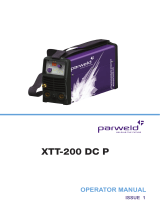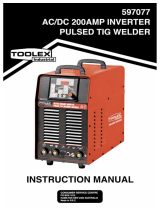
1 SAFETY
0463 418 001
- 5 -
© ESAB AB 2017
4. Wear flameproof gauntlet-type gloves, heavy long-sleeve shirt, cuffless pants,
high-topped shoes, and a welding helmet or cap for protection, to protect against arc
rays and hot sparks or hot metal. A flameproof apron may also be desirable as
protection against radiated heat and sparks.
5. Hot sparks or metal can lodge in rolled up sleeves, trouser cuffs, or pockets. Sleeves
and collars should be kept buttoned and open pockets eliminated from the front of the
clothing.
6. Protect other personnel from arc rays and hot sparks with a suitable non-flammable
partition or curtains.
7. Use goggles over safety glasses when chipping slag or grinding. Chipped slag may be
hot and can fly for long distances. Bystanders should also wear goggles over safety
glasses.
FIRES AND EXPLOSIONS
The heat from flames and arcs can start fires. Hot slag or sparks can
also cause fires and explosions. Therefore:
1. Protect yourself and others from flying sparks and hot metal.
2. Move all combustible materials well away from the work area or cover the materials
with a protective non-flammable covering. Combustible materials include wood, cloth,
sawdust, liquid and gas fuels, solvents, paints, and coating paper, etc.
3. Hot sparks or hot metal can fall through cracks or crevices in floors or wall openings
and cause a hidden smoldering fire or fires on the floor below. Make certain that such
openings are protected from hot sparks and metal.
4. Do not weld, cut, or perform other hot work until the work piece has been completely
cleaned so that there are no substances on the work piece which might produce
flammable or toxic vapors. Do not perform hot work on closed containers, they may
explode.
5. Have fire extinguishing equipment handy for instant use, such as a garden hose,
water pail, sand bucket, or portable fire extinguisher. Be sure you are trained in its
use.
6. Do not use equipment beyond its ratings. For example, an overloaded welding cable
can overheat and create a fire hazard.
7. After completing work, inspect the work area to make sure there are no hot sparks or
hot metal that could cause a fire later. Use fire watchers when necessary.
ELECTRICAL SHOCK
Contact between live electrical parts and earth can cause severe injury
or death. DO NOT use AC welding current in damp areas, if movement
is confined, or if there is danger of falling. Therefore:
1. Be sure the power source frame (chassis) is connected to the earth system of the
input power.
2. Connect the workpiece to a good electrical earth.
3. Connect the work cable to the workpiece. A poor or missing connection can expose
you or others to a fatal shock.
4. Use well-maintained equipment. Replace worn or damaged cables.
5. Keep everything dry, including clothing, work area, cables, torch/electrode holder and
power source.
6. Make sure that all parts of your body are insulated from both the work piece and from
the ground.
7. Do not stand directly on metal or the ground while working in tight quarters or a damp
area; stand on dry boards or an insulating platform and wear rubber-soled shoes.






















